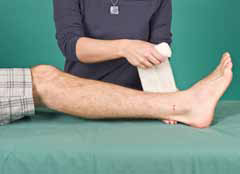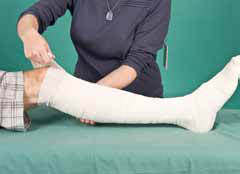You should treat all snake bites as dangerous.
Have I been bitten?
Signs of a snake bite aren’t always visible. In some cases, you may not even feel the snake bite you.
Symptoms of a snake bite might not appear for an hour or more. It’s important to act quickly if you think a snake has bitten you or someone else.
If a snake bites you or someone else don’t panic, run or try to catch the snake. You should move to a safe place and stay still. Don’t wash, suck or cut the bite site.
How to treat bites
If a snake bites you or someone else, call Triple Zero (000). If the person collapses or stops breathing, start resuscitation (CPR). Find out about how to perform CPR on the Healthdirect website.
What you do next depends on where the bite is.
Always lie the person down to stop them from walking or moving around until the ambulance arrives.
Leg bites
Call Triple Zero (000) and apply a bandage and splint. Make sure the bandage is comfortable, as it will need to be worn until a doctor removes it. Apply the bandage even if the person is already ill from the poison.
Keep the person’s whole body still and don’t remove their clothing. Moving them may cause more venom to enter the blood stream.
Apply the bandage and splint
Apply a broad pressure bandage over the bite site as soon as you can. Crepe bandages are best, but you can use any flexible material. For example, clothing or towels.

Bandage upwards from the lower part of the bitten leg. Wrap it firmly without stopping blood circulation. It should be as tight as you would apply to a sprained ankle.

Wrap the bandage as high as possible up the leg.

Apply a splint to the leg. You can use any stiff object as a splint, for example, a piece of wood or tree branch, or rolled up newspaper.

Bind it firmly to as much of the leg as possible.

Lie them down to stop them from walking or moving around until the ambulance arrives.
Hand or forearm bites
Call Triple Zero (000) and apply a bandage and splint. Make sure the bandage is comfortable, as it will need to be worn until a doctor removes it. Apply the bandage even if the person is already ill from the poison.
Keep the person’s whole body still and don’t remove their clothing. Moving them may cause more venom to enter the blood stream.
- Bandage as much of their arm as possible, starting at the fingers.
- Apply a splint to their arm, any stiff object can be used as a splint, for example, a piece of wood or tree branch, or rolled up newspaper.
- Use a sling to stop the arm moving.
- Lie them down to stop them walking or moving around until the ambulance arrives.
Chest, abdomen, pelvis and back bites
Call Triple Zero (000) and apply firm pressure over the bitten area, if possible.
Don’t restrict chest movement and keep the person's whole body still until the ambulance arrives.
Head and neck bites
Call Triple Zero (000) and keep the person's whole body still until the ambulance arrives.
Don't apply any first aid to the bitten area.
Prevent snake bites
You can help prevent bites:
- mowing the lawn and clearing the rubbish
- teaching children to never touch snakes
- making sure you and your children wear appropriate shoes to avoid bites
- getting a professional to remove snakes or nests.
Removing the snake
If you have a snake in your yard, don’t try to kill or capture it yourself. Find a local Snake Catcher to remove it. They may charge a fee.
Learn more about Queensland snakes on the Queensland Museum website.